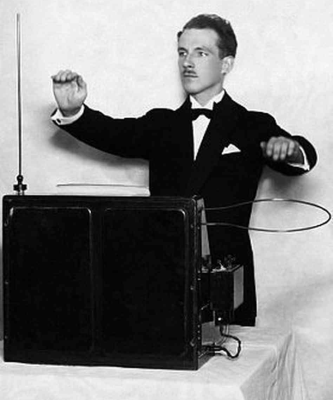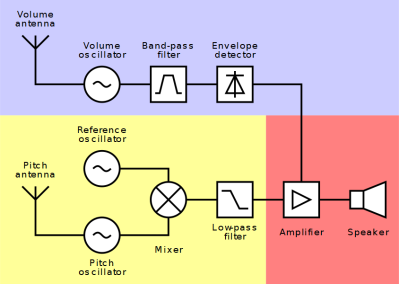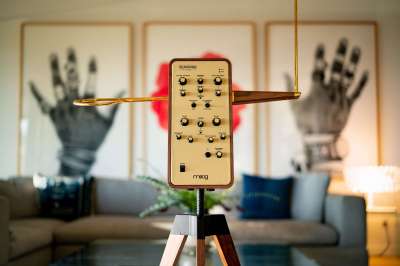It wouldn’t be October without Halloween, and it wouldn’t be Halloween without some spooky music. There’s no instrument spookier than a Theremin, which also happens to be one of the world’s first electronic instruments.

You’ve no doubt heard the eerie, otherworldly tones of the Theremin in various 1950s sci-fi films, or heard the instrument’s one-of-a-kind cousin, the Electro-Theremin in “Good Vibrations” by the Beach Boys. The Theremin turns 100 years old this month, so we thought we’d take a look at this strange instrument.
One hundred years ago, a young Russian physicist named Lev Sergeyevich Termen, better known as Leon Theremin, was trying to invent a device to measure the density of various gases. In addition to the standard analog needle readout, he wanted another way to indicate the density, so he devised an oscillator whistle that would change pitch based on the density.
He discovered by accident that having his hand in the field of the antenna changed the pitch of the whistle, too. Then he did what any of us would do — played around until he made a melody, then called everyone else in the lab over to check it out.
Theremin soon showed his device to Lenin, who loved it so much that he sent Lev on a world tour to show it off. While in New York, he played it for Rachmaninoff and Toscanini. In fact you can see a video recording of Leon playing the instrument, a performance that’s more hauntingly beautiful than spooky. In 1928, he patented the Theremin in the United States and worked with RCA to produce them.

How it Works
Sales never really took off, partially because of the Great Depression, but largely because it’s so hard to get a nice sound from it. The instrument was touted as being easy to play, because you really do just wave your hands in the air to play it. But the truth is that your hands must be placed precisely to avoid terrible squawking sounds. The Theremin is quite difficult to master, and few have done it.
Inside the Theremin are a pair of circuits — one to control pitch, and the other to control volume. The pitch circuit uses two tuned oscillators to produce sound. One is fixed, and the other is variable and connected to a vertical antenna. Sound is produced when the player’s hand enters the electromagnetic field around the antenna. The frequency produced by the players hand is subtracted from the reference frequency of the fixed oscillator in a process called heterodyning. The difference between the two frequencies is then amplified and sent through a speaker. The volume circuit is a single oscillator connected to a horizontal loop antenna. As the player’s hand gets closer to the antenna, the volume goes down, which makes it easy to chop the sound into individual notes.

Theremins are still being made today by Moog, and many of them have more bells and whistles that make them sound more complex compared to the first Theremin, which had a sine wave sound to it. One of the best and most expressive Theremin players was Clara Rockmore, and Moog is honoring her by releasing a limited edition Theremin this month. That’s Clara in the header image.
Things didn’t work out so well for Leon Theremin. In 1938, he was kidnapped and taken back to Russia by the KGB. He spent time in a prison camp and was later forced by the government to create a bug to spy on the United States. Theremin returned to the US in 1991 at the age of 95 and gave several concerts. He died in Moscow two years later.
Leon Theremin would likely be pleased to see how many spinoffs his invention has spurred. Here’s to 100 more years of spooky, ethereal music. Take a deep dive into how the instrument works and where the art is today with this interview with Carolin Eyck.
Thanks for the tip, [Qes]!
[Main image Clara Rockmore taken in 1932. Photo by Renato Toppo, © The Nadia Reisenberg / Clara Rockmore Foundation]
















She is REALLY good. I love the story of the man. From artist to Q branch. One thing about the Soviets…they are good designers…when it matters.
Yes, really good!
Halloween tomorrow – perfect day to blow the dust of the Moog digital Theremin. Not that anyone in the house has the foggiest idea of how to play it.
Nice article. Even spookier to me is the periods when the work was being performed where I’ve read somewhere regarding the Moscow Signal that connected Theremin and event occurring before the 1950’s and possibly going back to the 40’s or maybe 30’s. https://en.wikipedia.org/wiki/Leon_Theremin#Espionage
There are definitely physiological effects down to even infrasonic levels. Though is interesting to read about what is referenced regarding the other range of the spectrum regarding the visible range in the 1940’s. Makes me wonder about light, or any RF or pressure signal range, being used to cause physiological effects via heterodyne, pulse train or maybe even carrier modulation and demodulated signals on a target.
I am not sure what is being said here but I heard on NPR the other day that a Russian connection had been established to the Havana and other U.S.embassy personal where physiologically identifiable effects of intentional exposure to something (?) were confirmed.
I had the wonderful opportunity of playing with a real, homemade, theremin for several hours. What no digital theremin can do, since they are trying to imitate the “right” way of using it, is let you affect the electrical field in other ways. If I set it up differently, it reversed so that the sound plays louder the closer your hand gets — so it plays notes when you tap it. I could get all sorts of interesting effects from touching it in different ways.
Thanks to the great folks at Studio Faust for that opportunity: http://www.faust.cz/
Carolina’s name is misspelled in that last sentence…
I was just looking at her calendar of past performances. Wuhan for two days in mid-December 2019, followed a few days later by two performances in Beijing. They’re both huge cities, but wow, makes me think she dodged a bullet.
Leon Theremin invented one of the most brilliant spy devices of all time. https://en.wikipedia.org/wiki/The_Thing_(listening_device)
In the 60’s books had articles about the instrument but not Leon himself, he was still being hidden from the world. A few years ago someone had a Moog Etherwave for sale, I wish I had the money then. But I tried it out and it was silent. I opened it up and had to tune all 3 slug tuners to wake it up and got as much pitch range as I could and wasn’t satisfied. I went online and found that their latest model had more range, I had wrenched all the range out of that model. I tried playing it musically with an chord backing but couldn’t make it steady though I have steady hands.
This was before I made the steel guitar version of a theremin which I play with one steady hand being able to rest that hand on something tangible even though there are no frets or marks as to where the notes are. Now I would like to have another (pun) hands on experience with a theremin since I have developed such good muscle memory at pitch with the steel.
The theremin is also good thearpy.
https://www.youtube.com/watch?v=KQi6mw5m_Vc
No Theremin article is complete without mentioning Jon Spencer.
https://www.youtube.com/watch?v=vyF_UN8g9f0
The band Lothar and the Hand People had a little success in 1968 featuring a theremin. “Machines”, a cover of a Manfred Mann song, got some air play.
Astonishingly (to me) the vibrato opening of the Beach Boys “Good Vibrations” (among other things) *wasn’t* a Theremin, but a simpler-to-play offshoot (worth an article unto itself, hint hint) invented by Paul Tanner and Bob Whitsell in the 1950s that has seen a lot of use in movies and television.
https://www.npr.org/sections/allsongs/2013/02/07/171385175/no-it-wasn-t-a-theremin-on-good-vibrations-remembering-paul-tanner
No one plays a Theremin like Sheldon does…😁
https://youtu.be/_YYABE0R3uA
How can we talk about Theremin without naming Shedon?! :)
Myrtle Snow. No one has mentioned Myrtle Snow.
Silicon Chip magazine has published quite a few different designs, the most recent of which was in 2018: http://www.siliconchip.com.au/Issue/2018/January/Make+your+own+Theremin+%E2%80%93+then+make+music%21
Yes, you have to subscribe. Otherwise you can buy the kit, which comes with a copy of the article from https://www.jaycar.com.au/theremin-synthesiser-kit-mkiii/p/KC5537
I’m affiliated with these guys, but I did build the kit. It went together well, everything you need is in there except the linear power supply. If you have a heavy old wall-wart lying around, that will be fine. My Theremin “works,” but I suck at playing it :-)